So you think you've
Page 40
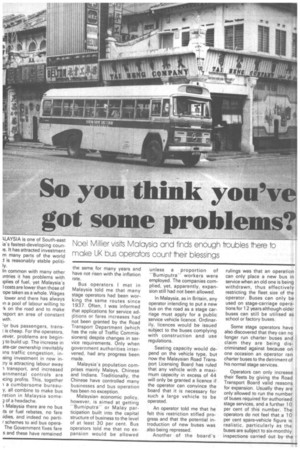
Page 41
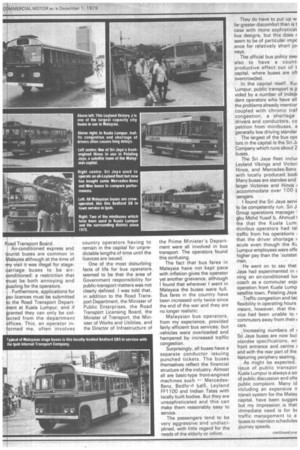
Page 42
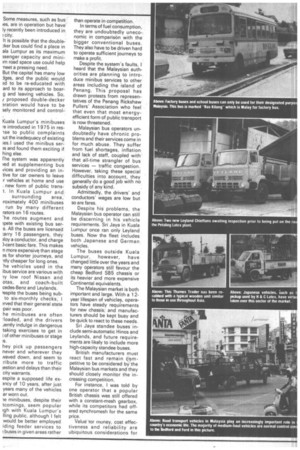
Page 43
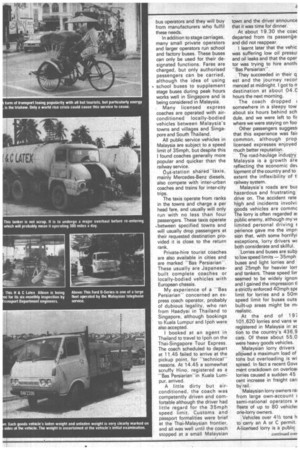
Page 44
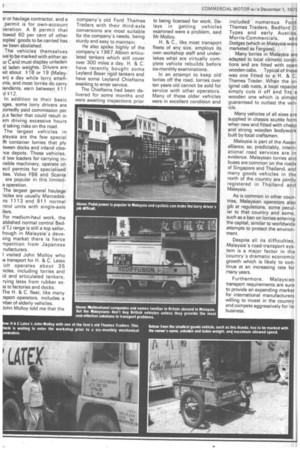
If you've noticed an error in this article please click here to report it so we can fix it.
got sonic problems?
Noel Millier visits Malaysia and finds enough troubles there to make UK bus operators count their blessings
\LAYSIA is one of South-east ia's fastest-developing counts. It has attracted investment m many parts of the world J is reasonably stable politily.
In common with many other intries it has problems with iplies of fuel, yet Malaysia's I costs are lower than those of ape taken as a whole. Wages lower and there has always !n a pool of labour willing to -k on the road and to make Isport an area of constant wth.
'or bus passengers, trans : is cheap. For the operators, 'ever, problems are beginto build up. The increase in ate-car ownership inevitably
ins traffic congestion, insing investment in new in:ry is attracting labour away -I transport, and increased ernmental controls are icing profits. This, together a cumbersome bureauy, all combine to make bus ration in Malaysia someof a headache.
Malaysia there are no bus its or fuel rebates, no fare ;idies, and indeed no parti r schemes to aid bus operaThe Government fixes fare s and these have remained the same for many years and have not risen with the inflation rate.
Bus operators I met in Malaysia told me that many stage operators had been working the same routes since 1937. Often, I was informed that applications for service additions or fares increases had not been granted by the Road Transport Department (which has the role of Traffic Commissioners) despite changes in service requirements. Only when government authorities intervened, had any progress been made.
Malaysia's population comprises mainly Malays, Chinese and Indians. Traditionally, the Chinese have controlled many businesses and bus operation has been no exception.
Malaysian economic policy, however, is aimed at getting "Bumiputra" or Malay participation built into the capital structure of business to the level of at least 30 per cent. Bus operators told me that no expansion would be allowed unless a proportion of "Bumiputra" workers were employed. The companies complied, yet, apparently, expansion still had not been allowed.
In Malaysia, as in Britain, any operator intending to put a new bus on the road as a stage carriage must apply for a public service vehicle licence. Ordinarily, licences would be issued subject to the buses complying with construction and use regulations.
Seating capacity would depend on the vehicle type, but now the Malaysian Road Transport Licensing Board has ruled that any vehicle with a maximum capacity in excess of 44 will only be granted a licence if the operator can convince the board that it is necessary for such a large vehicle to be operated.
An operator told me that he felt this restriction stifled progress and that the potential introduction of new buses was also being repressed.
Another of the board's
rulings was that an operation can only place a new bus in service when an old one is being withdrawn, thus effectively restricting the fleet size' of the operator. Buses can only be used on stage-carriage operations for 12 years although older buses can still be utilised as school or factory buses.
Some stage operators have also discovered that they can no longer run charter buses and claim they are being discriminated against because on one occasion an operator ran charter buses to the detriment of his normal stage services.
Operators can only increase their fleets by giving the Road Transport Board valid reasons for expansion. Usually they are only allowed to run the number of buses required for authorised stage services, and a further 10 per cent of this number. The operators do not feel that a 10 per cent spare-vehicle figure is realistic, particularly as the buses are subject to six-monthly inspections carried out by the oad Transport Board. Air-conditioned express and tburist buses are common in Malaysia although at the time of y visit it was illegal for stagecarriage buses to be aironditioned: a restriction that ust be both annoying and uzzling for the operators. Furthermore, applications for sv licences must be submitted o the Road Transport Depart ; ent at Kuala Lumpur, and if ranted they can only be colected from the department ffices. This, an operator informed me, often involves country operators having to remain in the capital for unpredictable lengths of time until the licences are issued.
One of the most disturbing facts of life for bus operators seemed to be that the area of Government responsibility for public-transport matters was not clearly defined. I was told that, in addition to the Road Transport Department, the Minister of Public Enterprises, the Road Transport Licensing Board, the Minister of Transport, the Minister of Works and Utilities, and the Director of Infrastructure of the Prime Minister's Department were all involved in bus transport. The operators found this confusing.
The fact that bus fares in Malaysia have not kept pace with inflation gives the operator yet another grievance, although I found that wherever I went in Malaysia the buses were full. Bus fares in the country have been increased only twice since the end of the war and they are no longer realistic.
Malaysian bus operators, from my experience, provided fairly efficient bus services; but .vehicles were overloaded and hampered by increased traffic congestion.
Surprisingly, all buses have a separate conductor issuing punched tickets. The buses themselves reflect the financial structure of the industry. Almost all are basic-type front-engined
machines such MercedesBenz, Bedfo-cl St35, Leyland. FF1100 and Indian Tatas with locally built bodies. But they are unsophisticated and this can make them reasonably easy to service.
The passengers tend to be very aggressive and undisciplined, with little regard for the needs of the elderly or infirm. They do have to put up w far greater discomfort than is t case with more sophisticat bus designs, but this does r seem to be of particular im pc ance for relatively short joi neys.
The official bus policy see' also to have a count' productive effect out of t capital, where buses are oft overcrowded.
In the capital itself, Ku; Lumpur, public transport is p vided by a number of indepi dent operators who have all the problems already mentior coupled with chronic traf congestion, a shortage drivers and conductors, co petition from minibuses, a generally low driving standar The largest of the bus OE tors in the capital is the Sri Company which runs about 2 buses.
The Sri Jaya fleet incluc Leyland Vikings and Victori Hinos, and Mercedes-Benz with locally produced bodi Many buses are standee and larger Victories and Hinos accommodate over 100 sengers.
I found the Sri Jaya servi to be competently run. Sri J. Group operations manager I gku Mohd Yusof b. Ahmud -me that the Kuala Lump minibus operators had ta I traffic from his operations ; that the driver shortage acute even though the KL Lumpur employees were offe higher pay than the "outstat: men.
He went on to say that Jaya had experimented in t fling an air-conditioned ILni coach as a commuter expi operation from Kuala Lump satellite town, Petaling Jaya Traffic congestion and lac flexibility in operating hours meant, however, that the vice had been unable to commuters away from their cars.
Increasing numbers of Sri Jaya buses are now bui standee specifications„ wi• front entrance and centre and with the rear part of the featuring periphery seating.
As might be expected, issue of public transpor Kuala Lumpur is always a so; of public discussion and ofte public complaint. Many d including an expensive n transit system for the Malay capital, have been sugges but my impression is that immediate need is for bE traffic management to a buses to maintain schedules journey speeds. Some measures, such as bus les, are in operation but have ly recently been introduced in city.
It is possible that the doubleker bus could find a place in ala Lumpur as its maximum ssenger capacity and mini
m road space use could help -neet a pressing need.
But the capital has many low iges, and the public would ?d to be re-educated with ard to its approach to boarg and leaving vehicles. So, / proposed double-decker ?ration would have to be sely monitored and control Kuala Lumpur's minibuses 'e introduced in 1 975 in res-Ise to public complaints )ut the inadequacy of existing ;es.I used the minibus ser?s and found them exciting if hing else.
The system was apparently led at supplementing bus vices and providing an intive for car owners to leave r vehicles at home and use new form of public transt. In Kuala Lumpur and surrounding area, roximately 400 minibuses run by many different rators on 16 routes.
The routes augment and Tete with existing bus sers. All the buses are licensed ;arry 16 passengers, they )loy a conductor, and charge )-cent basic fare. This makes
n more expensive than stage 3s for shorter journeys, and -itly cheaper for long ones. he vehicles used in the ibus service are various with
low roof Nissan and otas, and coach-built cedes-Benz and Leylands. lespite the buses being subto six-monthly checks, I )rved that their general state pair was poor.
he minibuses are often -loaded, and the drivers Jently indulge in dangerous taking exercises to get in of other minibuses or stage s.
hey pick up passengers never and wherever they Naved down, and seem to Tibute more to traffic iestion and delays than their city warrants.
espite a supposed life exincy of 10 years, after just years many of the vehicles ar worn out.
minibuses, despite their tcomings, seem popular igh with Kuala Lumpur's Iling public, although I felt would be better employed iding feeder services to ; buses in given areas rather than operate in competition.
In terms of fuel consumption, . they are undoubtedly uneco-. nomic in comparison with the bigger conventional buses, They also have to be driven hard to operate sufficient journeys to make a profit.
Despite the system's faults, I heard that the Malaysian authorities are planning to introduce minibus services to other areas including the island of Penang. This proposal has drawn protests from representatives of the Penang Rickshaw Pullers' Association who feel that even that most energyefficient form of public transport is now threatened.
Malaysian bus operators undoubtedly have chronic problems and their services come in for much abuse. They suffer from fuel shortages, inflation and lack of staff, coupled with that all-time strangler of bus services — traffic congestion. However, taking these special difficulties into account, they generally do a good job with no subsidy of any kind.
Admittedly, the drivers' and conductors' wages are low but so are fares.
Despite his problems, the Malaysian bus operator can still be discerning in his vehicle requirements. Sri Jaya in Kuala Lumpur once ran only Leyland buses. Now the fleet includes both Japanese and German vehicles.
The buses outside Kuala Lumpur, however, have changed little over the years and many operators still favour the cheap Bedford SB5 chassis or its heavier and more expensive Continental equivalents.
The Malaysian market is both important and large. With a 1 2year lifespan of vehicles, operators have steady requirements for new chassis; and manufacturers should be kept busy and be quick to react to these needs.
Sri Jaya standee buses include semi-automatic Hinos and Leylands, and future requirements are likely to include more high-capacity standee buses.
British manufacturers must react fast and remain Ompetitive to be considered by the Malaysian bus markets and they should closely monitor the increasing competition.
For instance, I was told by one operator that a popular British chassis was still offered with a constant-mesh gearbox, while its competitors had offered synchromesh for the same price.
Value tor money, cost effectiveness and reliability are ubiquitous considerations for bus operators and they will buy from manufacturers who fulfil these needs.
In addition to stage carriages, many small private operators and larger operators run school and factory buses. These buses can only be used for their designated functions. Fares are charged, but only authorised passengers can be carried, although the idea of using school buses to supplement stage buses during peak hours works well in Singapore and is being considered in Malaysia.
Many licensed express coaches are operated with air conditioned locally-bodied vehicles between Malaysia's towns and villages and Singapore and South Thailand.
All public service vehicles in Malaysia are subject to a speed limit of 35mph, but despite this I found coaches generally more popular and quicker than the railway service.
Out-station shared -fixis, mainly Mercedes-Benz diesels, also compete with inter-urban coaches and trains for inter-city trips.
The taxis operate from ranks in the towns and charge a per head fare, and usually will only run with no less than four passengers. These taxis operate ..between specified towns and will usually drop passengers at their requested destination provided it is close to the return rank.
Private-hire tourist coaches are also available in cities and are marked "Bas Persiarian''. These usually are Japanesebuilt complete coaches or locally-bodied vehicles with European chassis.
My experience of a "Bas Persiarian" concerned an express coach operator, probably of dubious legality, who ran from Haadyai in Thailand to Singapore, although bookings to Kuala Lumpur and I poh were also accepted.
I booked at an agent in Thailand to travel to I poh on the Thai-Singapore Tour Express. The coach scheduled to depart at 11.45 failed to arrive at the pickup point, for "technical" reasons. At 14.45 a somewhat scruffy Hino, registered as a —Bas Persiarian"in Kuala Lum.: pur, arrived.
A little dirty but airconditioned, the coach was competently driven and comfortable although the driver had little regard for the 35mph speed limit. Customs and passport formalities were brief at the Thai-Malaysian frontier, and all was well until the coach stopped at a small Malaysian town and the driver announce that it was time for dinner.
At about 19.30 the coac departed from its passengei and did not reappear.
I learnt later that the vehic was suffering low oil pressul and oil leaks and that the oper tor was trying to hire anoth, "Bas Persiarian".
They succeeded in their q est and the journey recor menced at midnight. I got to ry destination at about 04.0 hours the next morning.
The coach dropped t -somewhere in a sleepy tow about six hours behind sch dule, and we were left to fir where we were staying on foo.
Other passengers suggest( that this experience was fair common, although prop licensed expresses enjoyed much better reputation.
The road-haulage Industry Malaysia is a growth are reflecting the economic de). lopment of the country and to extent the inflexibility of t! railway system.
Malaysia's roads are bu. hazardous and frustrating drive on. The accident rate high and incidents involvii goods vehicles are commc The lorry is often regarded a( public enemy, although my v( limited personal driving E perience gave me the impri sion that, with some horrifyi exceptions, lorry drivers w( both considerate and skilful.
Lorries and buses are subj( to low speed limits — 35mph buses and light lorries and and 25mph for heavier lorr and tankers. These speed lirr seemed to be widely ignor( and I gained the impression tl a strictly enforced 40mph spc limit for lorries and a 50m speed limit for buses outs built-up areas might be ml realistic.
At the end of 193 101,620 lorries and vans w registered in Malaysia in ac tion to the country's 436,9 cars. Of these about 55,0 were heavy goods vehicles.
Malaysian lorry drivers allowed a maximum load of tons but overloading is wi spread. In fact a recent Gov( ment crackdown on overloa( lorries caused a sudden 45 cent increase in freight can by rail, Malaysian lorry owners rai from large own-account I semi-national operators )4 fleets of up to 80 vehicle; one-lorry owners.
Vehicles over 41/2 tons h to carry an A or C permit. A-licensed lorry is a public ar or haulage contractor, and a permit is for own-account Deration. A B permit that lowed 60 per cent of other aoples' goods to be carried has )w been abolished.
The vehicles themselves we to be marked with either an or C and must display unladen )d laden weights. Drivers are lid about $18 or 19 (Malayan) a day while lorry attenints, and most lorries do carry tendants, earn between $11 d$12.
In addition to their basic ages, some lorry drivers are Dortedly paid commission per p,a factor that could result in ern driving excessive hours d taking risks on the road.
The largest vehicles in Blaysia are the few special )ft container lorries that ply tween docks and inland clea-ice depots. These vehicles, d low loaders for carrying in-. risible machinery, operate onecil permits for specialised ties. Volvo F86 and Scania are popular in this limitedoperation.
The largest general haulage licles are usually Mercedesnz 1113 and 911 normal ritrol units with single-axle ilers.
For medium-haul work, the ablished normal control Bedd TJ range is still a top seller, hough in Malaysia's develing market there is fierce -npetition from Japanese nufacturers.
I visited John Molloy who is transport for H. & C. Latex ich operates about 35 iicles, including lorries and id and articulated tankers, rying latex from rubber esas to factories and docks.
The H. & C. fleet, like many isport operators, includes a nber of elderly vehicles.
John Molloy told me that the company's old Ford Thames Traders with their third-axle conversions are most suitable for the company's needs, being sturdy and easy to maintain.
He also spoke highly of the company's 1967 Albion articulated tankers which still cover over 300 miles a day. H. & C. have recently bought some Leyland Boxer rigid tankers and have some Leyland Chieftains awaiting to enter service.
The Chieftains had been delivered for some months and were awaiting inspections prior to being licensed for work. Delays in getting vehicles examined were a problem, said Mr Molloy.
H. & C., like most transport fleets of any size, employs its own workshop staff and undertakes what are virtually complete vehicle rebuilds before six-monthly examinations.
In an attempt to keep old lorries off the road, lorries over ten years old cannot be sold for service with other operators. Many of these older vehicles were in excellent condition and included numerous Ford. Thames Traders, Bedford 0Types and early Austins, Morris-Commercials, and Dodges (which in Malaysia were marketed as Fargoes).
Many lorries in Malaysia are adapted to local climatic conditions and are fitted with open wooden cabs. Typical of these was one fitted to a H. & C. Thames Trader. When the original cab rusts, a local repairer simply cuts it off and fits a wooden one which is almost guaranteed to outlast the veh.icle.
Many vehicles of all sizes are supplied in chassis scuttle form when new and fitted with cheap and strong wooden bodywork built by local craftsmen.
Malaysia is part of the Asean alliance, so, predictably, international road services are in evidence. Malaysian lorries and buses are common on the roads of Singapore and Thailand, and many goods vehicles in the north of the country are jointly registered in Thailand and Malaysia.
As is common in other countries, Malaysian operators also gib at regulations, some peculiar to that country and some, such as a ban on lorries entering the capital, similar to worldwide attempts to protect the environment.
Despite all its difficulties, ,Malaysia's road-transport system is a major factor in the 'country's dramatic economic growth which is likely to continue at an increasing rate for many years.
Furthermore, Malaysian transport requirements are sure to provide an expanding market for international manufacturers willing to invest in the country and compete aggressively for its business.
















































































































